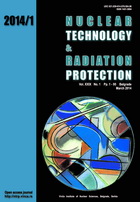
ENVIRONMENTAL DOSE RATE ASSESSMENT OF ITER USING THE MONTE CARLO METHOD
Pages: 34-39
Authors: Alireza Karimian, Amir Beheshti, Mohammadreza Abdi, and Iraj Jabbari
Abstract
Exposure to radiation is one of the main sources of risk to staff employed in reactor facilities. The staff of a tokamak is exposed to a wide range of neutrons and photons around the tokamak hall. The International Thermonuclear Experimental Reactor (ITER) is a nuclear fusion engineering project and the most advanced experimental tokamak in the world. From the radiobiological point of view, ITER dose rates assessment is particularly important. The aim of this study is the assessment of the amount of radiation in ITER during its normal operation in a radial direction from the plasma chamber to the tokamak hall. To achieve this goal, the ITER system and its components were simulated by the Monte Carlo method using the MCNPX 2.6.0 code. Furthermore, the equivalent dose rates of some radiosensitive organs of the human body were calculated by using the medical internal radiation dose phantom. Our study is based on the deuterium-tritium plasma burning by 14.1 MeV neutron production and also photon radiation due to neutron activation. As our results show, the total equivalent dose rate on the outside of the bioshield wall of the tokamak hall is about 1 mSv per year, which is less than the annual occupational dose rate limit during the normal operation of ITER. Also, equivalent dose rates of radiosensitive organs have shown that the maximum dose rate belongs to the kidney. The data may help calculate how long the staff can stay in such an environment, before the equivalent dose rates reach the whole-body dose limits.
Key words: tokamak, dose, radiation dose phanton, MCNPX 2.6.0 code
FULL PAPER IN PDF FORMAT (498 KB)
